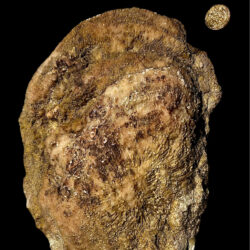-
Charles Du posted a new activity comment 1 month, 2 weeks ago
1 month, 2 weeks ago1 month, 2 weeks agoCalamite stem probably.
-
Charles Du posted a new activity comment 2 months ago
2 months ago2 months agoLooks like Rugose to me.
-
-
-
-
-
Charles Du posted a new activity comment 3 months, 1 week ago
3 months, 1 week ago3 months, 1 week agoYou posted a few other marine specimens that appear to have been collected together. Paleozoic specimens.
-
Charles Du posted a new activity comment 3 months, 1 week ago
3 months, 1 week ago3 months, 1 week agoMore likely some species of sponge. 🧽
-
Charles Du posted a new activity comment 3 months, 1 week ago
3 months, 1 week ago3 months, 1 week agoCorrection, photo one is Gastropods, photo two is a cephalopod. 🐌 🦑
-
Charles Du posted a new activity comment 3 months, 1 week ago
3 months, 1 week ago3 months, 1 week agoI believe these are not cephalopods, but gastropods. 🐌
-
Charles Du posted a new specimen in the group
 What is it? from the myFOSSIL app 4 months ago4 months ago4 months ago
What is it? from the myFOSSIL app 4 months ago4 months ago4 months agoCharles Du has contributed specimen mFeM 157407 to myFOSSIL!
-
Charles Du posted a new activity comment 4 months ago
4 months ago4 months agoEnchodus is an extinct genus of aulopiform ray-finned fish related to lancetfish and lizardfish. Species of Enchodus flourished during the Late Cretaceous, and there is some evidence that they may have survived to the Paleocene or Eocene.
-
Charles Du posted a new activity comment 4 months ago
4 months ago4 months agoI agree with both of these responses. Enchodus teeth are real, but the jaw bones are not.
-
Charles Du posted a new activity comment 4 months ago
4 months ago4 months agoNot a tooth. It’s some very eroded petrified wood.
-
Charles Du posted a new activity comment 4 months ago
4 months ago4 months agoLooks like rugose coral. 🪸
-
Charles Du posted a new activity comment 4 months ago
4 months ago4 months agoThis marine sediment is far too old to have any petrified wood in it.
-
Charles Du posted a new activity comment 4 months ago
4 months ago4 months agoIt is indeed a Archimedes bryozoan.
-
Charles Du posted a new activity comment 4 months, 2 weeks ago
4 months, 2 weeks ago4 months, 2 weeks agoCrinoid
-
Charles Du posted a new activity comment 4 months, 2 weeks ago
4 months, 2 weeks ago4 months, 2 weeks agoRugose horn coral
-
Charles Du posted a new activity comment 5 months, 2 weeks ago
5 months, 2 weeks ago5 months, 2 weeks agoThese look like bits of shells.
- Load More
